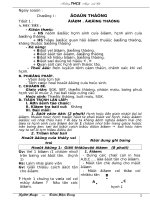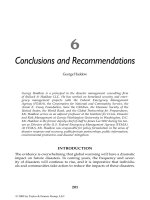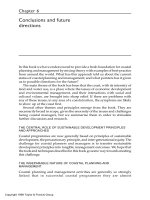Chapter 6.1: Network Management
Bạn đang xem bản rút gọn của tài liệu. Xem và tải ngay bản đầy đủ của tài liệu tại đây (835.39 KB, 44 trang )
Chapter 6.1:
Network Management
NGUYỄN CAO ĐẠT
E-mail:
Hochiminh City University Of Technology
Computer Science & Engineering
© 2014
Computer Networks 2
Chapter 6: Network Management
1
Outline
Introduction
What is network management?
Evolution of Network Management
ISO Network Management Categories
Infrastructure for network management
Hochiminh City University Of Technology
Computer Science & Engineering
© 2014
Computer Networks 2
Chapter 6: Network Management
2
Introduction
In the early days, network was small
Network management job includes
Installation: attach PCs, printers, etc. to LAN
Configuration: NICs, protocol stack, user app’s
shared printers, etc.
Testing: Ping was sufficient to “manage”
network
Config more devices: hub, switch, router, ..
Hochiminh City University Of Technology
Computer Science & Engineering
© 2014
Computer Networks 2
Chapter 6: Network Management
3
Introduction
Above only deals with configuration
Ongoing maintenance issues
How
How
How
How
How
to
to
to
to
to
optimize performance?
handle failures and network changes?
extend network capacity?
account for network usages?
solve network security issues?
Hochiminh City University Of Technology
Computer Science & Engineering
© 2014
Computer Networks 2
Chapter 6: Network Management
4
Introduction
Today, networks are larger and more complicated,
so more demands on network manager
How to monitor and control the network effectively
and timely?
Management tools are needed
Network-based management tools: use the
network to manage the network (remotely)
Solving problem procedures
Hochiminh City University Of Technology
Computer Science & Engineering
© 2014
Computer Networks 2
Chapter 6: Network Management
5
A Case Study
Typical problem
Remote user arrives at
regional office and experiences
slow or no response from
corporate web server
Remote User
Regional Offices
Where do you begin?
Where is the problem?
What is the problem?
What is the solution?
Without proper network
management, these
questions are difficult to
answer
Hochiminh City University Of Technology
Computer Science & Engineering
© 2014
WWW Servers
Corp Network
Computer Networks 2
Chapter 6: Network Management
6
A Case Study
With proper management tools
and procedures in place, you
may already have the answer
Consider some possibilities
What configuration changes
were made overnight?
Have you received a device fault
notification indicating the issue?
Have you detected a security
breach?
Has your performance baseline
predicted this behavior on an
increasingly congested network
link?
Hochiminh City University Of Technology
Computer Science & Engineering
© 2014
Remote User
Regional Offices
WWW Servers
Corp Network
Computer Networks 2
Chapter 6: Network Management
7
Solving Problem Procedure
An accurate database of
your network’s topology,
configuration, and
performance
Response Times
A solid understanding of the
protocols and models used
in communication between
your management server and
Predictability
the managed devices
Methods and tools that
allow you to interpret and act
upon gathered information
Hochiminh City University Of Technology
Computer Science & Engineering
© 2014
High
Availability
Security
Computer Networks 2
Chapter 6: Network Management
8
Outline
Introduction
What is network management?
Evolution of Network Management
ISO Network Management Categories
Infrastructure for network management
Hochiminh City University Of Technology
Computer Science & Engineering
© 2014
Computer Networks 2
Chapter 6: Network Management
9
What is network management?
Definition by Saydam (in Journal of Networks and
System Management, published in Dec. 1996)
"Network management includes the deployment,
integration and coordination of the hardware,
software, and human elements to monitor, test,
poll, configure, analyze, evaluate, and control
the network and element resources to meet the
real-time, operational performance, and Quality
of Service requirements at a reasonable cost."
Hochiminh City University Of Technology
Computer Science & Engineering
© 2014
Computer Networks 2
Chapter 6: Network Management
10
What is network management?
Goal
To ensure that the users of a network receive
the IT services with the quality of service
(QoS) that they expect.
Hochiminh City University Of Technology
Computer Science & Engineering
© 2014
Computer Networks 2
Chapter 6: Network Management
11
Outline
Introduction
What is network management?
Evolution of Network Management
ISO Network Management Categories
Infrastructure for network management
Hochiminh City University Of Technology
Computer Science & Engineering
© 2014
Computer Networks 2
Chapter 6: Network Management
12
Evolution of Network Management
In 1977 International Organization for
Standards (ISO) began work on Open
Systems Interconnection (OSI) reference
model
Purpose was to “provide a common basis for the
coordination of standards developments for the
purpose of system interconnection, while
allowing existing standards to be placed in
perspective within the overall Reference Model”
OSI model published in 1984
Hochiminh City University Of Technology
Computer Science & Engineering
© 2014
Computer Networks 2
Chapter 6: Network Management
13
Evolution of Network Management
In March 1987, effort to develop Simple
Gateway Monitoring Protocol (SGMP)
About same time Common Mgmt
Information Protocol (CMIP) developed for
OSI model
SGMP out by November 1987
Could “get” and “set” variable values
CMIP is roughly SNMP for the OSI model
Effort to develop CMIP Over TCP (CMOT) as
alternative to SGMP
Hochiminh City University Of Technology
Computer Science & Engineering
© 2014
Computer Networks 2
Chapter 6: Network Management
14
Evolution of Network Management
CMIP uses Remote Operations Services
Elements (ROSE)
ROSE is for communication with distributed apps
in OSI model
OSI mgmt process is richer and more
comprehensive than that provided by SNMP
But OSI approach is more complex and took
longer to develop
SNMP: “keep it simple”, and it’s good enough
So SNMP won out in practice
Hochiminh City University Of Technology
Computer Science & Engineering
© 2014
Computer Networks 2
Chapter 6: Network Management
15
Evolution of Network Management
Due to controversy/delays in OSI approach, Internet
Activities Board (IAB) held meeting in 1988
Decided to pursue both CMOT and SGMP
Eventually abandoned CMOT (complexity)
Eventually, three RFCs resulted…
The three RFCs
Structure of Management Information (SMI), uses
Abstract Syntax Notation One (ASN.1)
Management Information Base (MIB), the data structure
on the mgmt agent
Simple Network Management Protocol (SNMP)
By 1989, SNMP was the de facto standard for management
of TCP/IP networks
Hochiminh City University Of Technology
Computer Science & Engineering
© 2014
Computer Networks 2
Chapter 6: Network Management
16
Outline
Introduction
What is network management?
Evolution of Network Management
ISO Network Management Categories
Infrastructure for network management
Hochiminh City University Of Technology
Computer Science & Engineering
© 2014
Computer Networks 2
Chapter 6: Network Management
17
Top-down View of NM functions
Hochiminh City University Of Technology
Computer Science & Engineering
© 2014
Computer Networks 2
Chapter 6: Network Management
18
Nework Management Functional
Hochiminh City University Of Technology
Computer Science & Engineering
© 2014
Computer Networks 2
Chapter 6: Network Management
19
ISO Network Management Categories
Fault Management
Configuration Management
keep track of usage for charging
Performance Management
identify managed resources and their connectivity, discovery
Accounting Management
detection, isolation and correction of abnormal operations
monitor and evaluate the behavior of managed resources
Security Management
allow only authorized access and control
FCAPS
Hochiminh City University Of Technology
Computer Science & Engineering
© 2014
Computer Networks 2
Chapter 6: Network Management
20
Fault Management
Manages network problems to keep the
network running reliably and efficiently.
Fault management process involves the
following steps
Detecting the problem symptoms.
Isolating the problem.
Fixing the problem automatically (if possible) or
manually.
Logging the detection and resolution of the
problem.
Hochiminh City University Of Technology
Computer Science & Engineering
© 2014
Computer Networks 2
Chapter 6: Network Management
21
Configuration Management
Configuration Management monitors network and
system configuration information and stores it in a
configuration management database.
The maintenance of this database allows network
administrators to track hardware, software, and
other network resources
Hochiminh City University Of Technology
Computer Science & Engineering
© 2014
Computer Networks 2
Chapter 6: Network Management
22
Configuration Management
Each network device has a variety of
information associated with it:
Software version information for the operating
system, protocol software, or management
software.
Hardware version information for the interfaces
or hardware controllers.
Contact information indicating who to contact if
problems with the device arise.
Location information indicating the physical
location of the device.
Hochiminh City University Of Technology
Computer Science & Engineering
© 2014
Computer Networks 2
Chapter 6: Network Management
23
Configuration Management
CM Information Associated with a Managed Device
Hochiminh City University Of Technology
Computer Science & Engineering
© 2014
Computer Networks 2
Chapter 6: Network Management
24
Accounting Management
Measures network utilization parameters in
order to regulate individual and group uses
of the network.
Minimizes network problems and maximizes
fairness of user access to the network
because network resources can be portioned
based on network capacity and user needs.
Hochiminh City University Of Technology
Computer Science & Engineering
© 2014
Computer Networks 2
Chapter 6: Network Management
25









